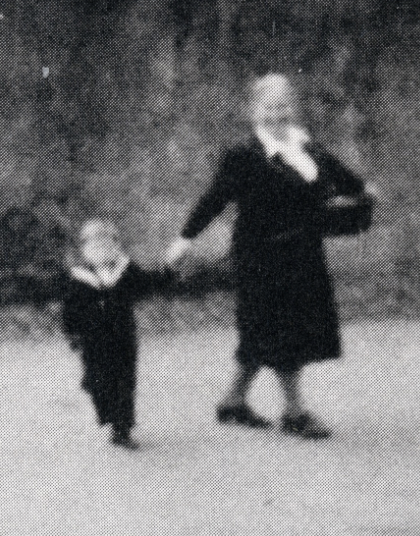Memorabilia’s Gaze:
Identities Deteriorated Through Images

Leo Horton, Do I Know You? (2020)
I
must admit it was difficult finding how to begin this essay. Against my better
judgment I decided to preface it with the image above. The subject is that of a
woman looking at you, neatly framed in a square of blue. Her black hair is
slightly messy and whatever she is wearing is near fully concealed out of frame.
She appears fairly young, though her exact age is largely ambiguous. Likely on
account of its printing, the entire image is blurred and diffused in a slight
layer of grain, but her features yet rise out well defined and barely obscured.
Perhaps you are encouraged to look eye to eye for a moment and confront one
another directly. Maybe you are savoring the space or time between one another,
or perhaps you are in a quick dismissal of your shared connection. Maybe yet
the prolonged eye contact, like straining your eyes in an eternal staring
contest, makes you uncomfortable and encourages you to look elsewhere.
If you were to happen to look away from the image, scroll down, turn the page or lose sight of her for a moment I wonder if, at this point, you might easily conjure her face to mind. It is likely best for my purposes if you can, but if you cannot, it is surely no fault of your own. I would hope however, if you were to see her passing on the street, you would think “I’m not quite sure but I think I saw a picture of that woman in the beginning of an essay I was reading recently”. If you were to call out, expressing this sentiment to her, maybe she would look at you with a gaze slightly like that above.
I include this image, which is generated by a machine learning algorithm in order to appear like a true human face, to express the tragedy of recognition. Every feature was tweaked (on scales such as hair color, age, weight, ethnicity and happiness) in order to visually assemble a hypothetical someone. This subject lacks a voice, an age, a context or a name. The back of their head, the bottoms of their feet, the content of their character and the blades of their shoulders are mere speculation. Their eyes have never seen, their ears have never heard, and their teeth have never bitten. This may leave you with some sense of deception, but it is largely a measure of the power of your recognition senses in tandem with the very nature of photographs. The technology at hand to produce these images is surely not seamless or consistent enough to create a fully believable image-based reality, but it can only be anticipated. This image could very well have been that of a single sock lost in the laundry, a historical event that has come and gone, a house burnt down several months ago or a deceased loved one – that is to mean as a seamless visual signifier for something entirely absent. The relationship between the subject of the image and you, the viewer, is both as shallow as the surface it rests on and as profoundly immeasurable as the interpretation that occurs somewhere hidden just behind your own gaze.
If you were to happen to look away from the image, scroll down, turn the page or lose sight of her for a moment I wonder if, at this point, you might easily conjure her face to mind. It is likely best for my purposes if you can, but if you cannot, it is surely no fault of your own. I would hope however, if you were to see her passing on the street, you would think “I’m not quite sure but I think I saw a picture of that woman in the beginning of an essay I was reading recently”. If you were to call out, expressing this sentiment to her, maybe she would look at you with a gaze slightly like that above.
I include this image, which is generated by a machine learning algorithm in order to appear like a true human face, to express the tragedy of recognition. Every feature was tweaked (on scales such as hair color, age, weight, ethnicity and happiness) in order to visually assemble a hypothetical someone. This subject lacks a voice, an age, a context or a name. The back of their head, the bottoms of their feet, the content of their character and the blades of their shoulders are mere speculation. Their eyes have never seen, their ears have never heard, and their teeth have never bitten. This may leave you with some sense of deception, but it is largely a measure of the power of your recognition senses in tandem with the very nature of photographs. The technology at hand to produce these images is surely not seamless or consistent enough to create a fully believable image-based reality, but it can only be anticipated. This image could very well have been that of a single sock lost in the laundry, a historical event that has come and gone, a house burnt down several months ago or a deceased loved one – that is to mean as a seamless visual signifier for something entirely absent. The relationship between the subject of the image and you, the viewer, is both as shallow as the surface it rests on and as profoundly immeasurable as the interpretation that occurs somewhere hidden just behind your own gaze.

Captioned: Die Viehandlung Katz vor 1938, heute Haushaltswarengeschäft Lisette Wagner.
This next image is
sourced from a book, Bilder aus alt-Wehrheim (Pictures of old-Wehrheim),
my grandmother passed down to me recently. The book is about Wehrheim, a town
in West Germany from which she and her parents, as Jews facing impending persecution
in the rising fascist climate of Nazi Germany, emigrated from in 1937. Two
copies of the book, one which she still owns and one which currently sits in me
and my brother’s living room, were sent to our family of Jewish Immigrants in
America as a small gesture of good faith after the war. It documents, in a
largely objective manner, a collection of everyday scenes from the town taken
over the 1930’s. Within the book (which is entirely in German) there are a
number of family portraits, cows towing fields, flocks of sheep being
shepherded through the streets, sports teams posing before important matches,
military parades being fervently celebrated, and musicians caught paused in
play. Within some images the darker context of the period will shine through,
and a swastika will emerge emblazoned on a banner behind a crowd or a family
member will be photographed with a now-taboo square mustache. All of these
details become momentous in revisional viewings, but at the time the
photographs, which are largely uncredited and assembled long after their taking,
are meant only to document the everyday life of a tight-knit local community.
Each photo was likely taken with the same casualness that any other photograph
might happen to be taken with, and only later, through many lenses and anecdotes,
they are assigned the role of capturing a wildly uncertain period of time within
a location at the precipice of world changing events.
The image’s caption when translated from German reads: “The Cattle Dealership of the Katz Family in 1938, now the home supply store of Lisette Wagner”. Within the rural countryside, in towns like Weirheim, much of the Jewish population worked as cattle dealers and handled beef products exclusively as one of the few industries available to the Semitic minority. The building in the background of the photograph, which is identified as belonging to the Katz family (Katz being my grandmother’s maiden name), was documented a year after it was sold to fund my family’s escape. This structure is the node through which I am linked to this particular image and the source of its relevance to me. Despite that I find myself far less interested in the building in the background and am far more deeply engaged with the two figures recorded in the foreground. Perhaps a mother and son, both hold one another’s hands as they walk down the road. They exist as a beacon of familiarity, forming my mental image of old Wehrheim. They are the figures that populate the corners of history, comparable to the archetypal women and children of the proverbial home front. Captured in this photo only by chance, their two gazes, blurred beyond all recognition, break through decades of history to look at yours now.
The image’s caption when translated from German reads: “The Cattle Dealership of the Katz Family in 1938, now the home supply store of Lisette Wagner”. Within the rural countryside, in towns like Weirheim, much of the Jewish population worked as cattle dealers and handled beef products exclusively as one of the few industries available to the Semitic minority. The building in the background of the photograph, which is identified as belonging to the Katz family (Katz being my grandmother’s maiden name), was documented a year after it was sold to fund my family’s escape. This structure is the node through which I am linked to this particular image and the source of its relevance to me. Despite that I find myself far less interested in the building in the background and am far more deeply engaged with the two figures recorded in the foreground. Perhaps a mother and son, both hold one another’s hands as they walk down the road. They exist as a beacon of familiarity, forming my mental image of old Wehrheim. They are the figures that populate the corners of history, comparable to the archetypal women and children of the proverbial home front. Captured in this photo only by chance, their two gazes, blurred beyond all recognition, break through decades of history to look at yours now.

The history therefore that I tend to look at and that I hope to record is populated by glimpses and glances, squeezed through blurry records to populate the present. I am under the impression that when a gaze meets yours through an image, a subject compels you to try and recognize. This is an image of a woman and child. They walk hand in hand through the street. Behind their head is my family’s symbol of forfeiture. A year after the photo is taken Germany marches into the throws of war. Eight years later it surrenders. Like the image at the beginning, these two subjects lack a voice, an age, a context or a name. The turn of their heads after the snapshot, their continued steps down the street, the content of their character and the trials they might face are only mere speculation.
With that in mind I would like to draw these two images, a generated face and a blurry mother and child in the street, into a shared conversation. The lives behind the images, and the richness of their anticipated stories, are not in any way contingent on the quality with which they are recorded in, but on some unclear sense of proximity to an embodied reality. The first image is far clearer, but the second one is far richer. In a general sense it is real images like that taken in Wehrheim, and a thousand more like it, which are used to shape the features of a generated image like Do I Know You? This pair is in origins and reality nothing alike, yet through vastly different methods they arrive to us with the same familiar gaze. With the eventual turn of a page, the snap of a camera or the closure of a window one disappears, and another turns the corner and walks on to its own out-of-frame finale.
Everyone on all sides of the equation of gazes are merely speculating, and what we know of each subject becomes a taciturn semblance of understanding – grasping for familiarity in faces we do not known. With this general concept in mind, I’d like to explain what makes both of these images so valuable to me and my work; the uncertainty. There is a great uncertainty in a vision of the past that is more closely aligned with our model of the future; one reminiscent of slippery steppingstones in a vast, foggy ocean. Somewhere, out in that cloudy murky sea of history, messages in bottles are bobbing away. Images, as methods of visual documentation, serve to map the entire world we don’t visit and times we didn’t live through. Gazes, like the beams of a lighthouse, sear from the past into the future to remind us these stormy seas are populated by an inconceivable milieu of personal experiences just like our everyday. Some could be reminders, and others could be mirages. They are recorded, through mere glimpses, in boundless amounts of memorabilia. Memorabilia that is hopelessly distorted, mediated through a series of instruments can only deteriorated down to that which can only be recognized.
︎︎︎ ︎︎︎








